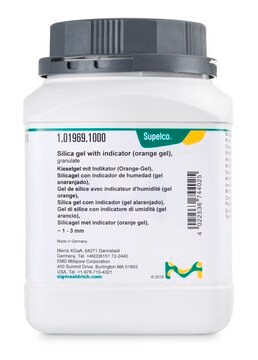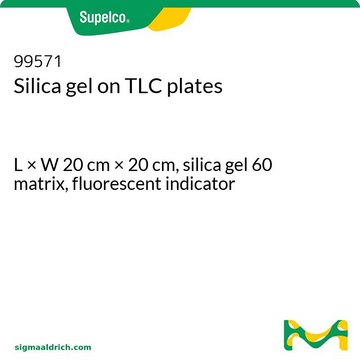60765
Gel di silice
high-purity grade, with ~15% calcium sulfate and fluorescent indicator, GF254, suitable for thin layer chromatography (TLC)
Autenticatiper visualizzare i prezzi riservati alla tua organizzazione & contrattuali
About This Item
Numero CAS:
Numero CE:
Numero MDL:
Codice UNSPSC:
41115711
ID PubChem:
NACRES:
NC.07
Prodotti consigliati
Grado
high-purity grade
Livello qualitativo
Stato
powder
Qualità
with ~15% calcium sulfate and fluorescent indicator
Produttore/marchio commerciale
Sigma-Aldrich
tecniche
thin layer chromatography (TLC): suitable
Area superficiale
500 m2/g
Dimensione particelle
<20 μm
>632 mesh
Dimensione pori
0.8 cm3/g pore volume
60 Å pore size
P. ebollizione
2230 °C
Punto di fusione
>1600 °C
Stringa SMILE
O=[Si]=O
InChI
1S/O2Si/c1-3-2
VYPSYNLAJGMNEJ-UHFFFAOYSA-N
Cerchi prodotti simili? Visita Guida al confronto tra prodotti
Descrizione generale
Silica gel is a rigid 3D network of colloidal silica. It is exclusively used as a support material for the active titanium(III) centers in Ziegler-Natta catalysts. Silica gel allows a controlled fragmentation resulting in the formation of uniform polymer particles with narrow particle size distribution and high bulk density. Silica gel is classified as below:
a. Aquagel - pores are filled with water
b. Xerogel - by the process of evaporation, aqueous phase in the pores are removed
c. Aerogel - solvent is removed by supercritical extraction
a. Aquagel - pores are filled with water
b. Xerogel - by the process of evaporation, aqueous phase in the pores are removed
c. Aerogel - solvent is removed by supercritical extraction
Applicazioni
- Chromatographic Separation: Silica gel is widely used as a stationary phase in chromatography for the separation of various chemical compounds. Innovations in silica gel modification, such as pentabromobenzyl group-modified silica gel, have enhanced the separation efficiency for metabolites like nicotinamide. This application is critical for pharmaceutical analysis and metabolomics studies, providing high precision and accuracy in the quantification of biologically relevant molecules (Ozaki et al., Analytical Biochemistry, 2022).
- Environmental Pollutant Detection: Silica gel is used to create molecularly imprinted polymers (MIPs) that selectively recognize and bind environmental pollutants. A notable application involves the embedding of quantum dots in molecularly imprinted silica gel to detect aminoimidazo-azaarenes (AIAs) in food samples. This method offers high selectivity and sensitivity, making it a powerful tool for food safety and environmental monitoring (Qiao et al., Current Analytical Chemistry, 2021).
Prodotti correlati
N° Catalogo
Descrizione
Determinazione del prezzo
Codice della classe di stoccaggio
11 - Combustible Solids
Classe di pericolosità dell'acqua (WGK)
nwg
Punto d’infiammabilità (°F)
Not applicable
Punto d’infiammabilità (°C)
Not applicable
Dispositivi di protezione individuale
Eyeshields, Gloves, type N95 (US)
Scegli una delle versioni più recenti:
Possiedi già questo prodotto?
I documenti relativi ai prodotti acquistati recentemente sono disponibili nell’Archivio dei documenti.
I clienti hanno visto anche
T Martin et al.
Chemical communications (Cambridge, England), (1)(1), 24-25 (2002-07-18)
Texture-related features of water intrusion in hydrophobised MCM-41 silicas render these materials especially suitable for energy dissipation in mechanical dampers.
A simple method for production of pure silica from rice hull ash
Kalapathy, U., A. Proctor, and J. Shultz.
Bioresource Technology, 73, 257-262 (2000)
Silica gel supported zirconocene dichloride/methylalumoxane catalysts for ethylene polymerization: Effects of heterogenation on activity, polymer microstructure and product morphology.
Janiak, Christoph, and Bernhard Rieger.
Angew. Makromol. Chem., 215, 47-57 (1994)
Il team dei nostri ricercatori vanta grande esperienza in tutte le aree della ricerca quali Life Science, scienza dei materiali, sintesi chimica, cromatografia, discipline analitiche, ecc..
Contatta l'Assistenza Tecnica.


